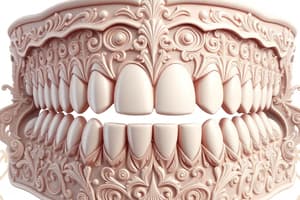Podcast
Questions and Answers
What is a common material used to make occlusion rims?
What is a common material used to make occlusion rims?
- Tin foil
- Pink modeling wax (correct)
- Zn & Eugenol impression material
- Plaster and pumice
What is the average height of the upper occlusion rim anteriorly?
What is the average height of the upper occlusion rim anteriorly?
- 20 mm
- 24 mm
- 22 mm (correct)
- 18 mm
What is one of the uses of an occlusion rim?
What is one of the uses of an occlusion rim?
- Support for lip and cheeks
- Re lining of temporary trial denture bases
- Registration of jaw relationships (correct)
- Choosing the material for denture construction
What is the name of the method used with modeling compound occlusion rims?
What is the name of the method used with modeling compound occlusion rims?
What is the average distance from the lower sulcus to the incisal edge of the lower central incisor?
What is the average distance from the lower sulcus to the incisal edge of the lower central incisor?
What is the primary purpose of occlusion blocks in denture construction?
What is the primary purpose of occlusion blocks in denture construction?
Which of the following is a requirement of a trial denture base?
Which of the following is a requirement of a trial denture base?
What is the advantage of using resin temporary trial denture base over shellac base?
What is the advantage of using resin temporary trial denture base over shellac base?
What is the disadvantage of using permanent trial denture base?
What is the disadvantage of using permanent trial denture base?
What is the advantage of using metal bases in denture construction?
What is the advantage of using metal bases in denture construction?
Flashcards are hidden until you start studying
Study Notes
Occlusion Blocks
- Occlusion blocks consist of occlusion rims attached to well-fitting trial denture bases.
- Uses of trial denture bases:
- Carries occlusion rims for recording jaw relations
- Carries teeth for the try-in stage
- Checks accuracy of the final impression
Requirements of a Trial Denture Base
- Must be:
- Rigid
- Accurately adapted to the cast with proper extensions
- Dimensionally stable with minimal warpage
- Relieved from undercuts to avoid scraping the cast
- Clean and smooth for patient comfort
- Proper thickness (2mm in H.P.)
- Easy to construct
Types of Trial Denture Bases
- Temporary trial denture base
- Permanent trial denture base
Materials Used for Temporary Trial Denture Base
- Hard base plate wax
- Shellac base-plate
- Cold curing acrylic resin
- Swaged tin
Advantages of Resin T.D.B over Shellac Bases
- Accurate fit to the cast
- High strength
- Dimensionally stable in the mouth
Materials Used for Permanent Trial Denture Base
- Heat cured acrylic resin
- Cast gold
- Chromium-nickel alloy
- Chromium-cobalt alloy
Advantage of Permanent Trial Denture Base
- Gives good idea about extension, retention, and stability of the final denture
Disadvantage of Permanent Trial Denture Base
- Additional shrinkage on second processing when teeth are added
Heat Cured Acrylic Resin (H.C.A.R.)
- Advantages:
- Strong and rigid
- Control thickness during waxing up
- Minimizes dimensional changes
- T.D.B becomes part of the denture
- Disadvantages:
- Time-consuming
- Need to construct mounting casts
- Warpage occurs during second processing to attach teeth
Metal Bases
- Advantages:
- No acrylic warpage
- More strength
- More accurate
- Less tissue change under the base
- More hygienic (less porosity)
- Good thermal conductivity
- Less deformation in function
- Disadvantages:
- Cost
- Difficulty in relining
- Time-consuming
Stabilization of Recording Bases
- Additional stabilization required with temporary trial denture bases through relining with Zn & Eugenol impression material after adaptation of tin foil to the master cast
Occlusion Rims
- Made of pink modeling wax
- Uses of occlusion rim:
- Registration of jaw relationships
- Choice of artificial teeth
- Setting up of teeth
- Support for lip and cheeks
Dimensions of Occlusal Rims
- Average height of upper occlusion rim anteriorly: 22mm
- Average distance from lower sulcus to incisal edge of lower central incisor: 16mm
- Posterior vertical height of maxillary occlusion rim: 6-8mm
- Posterior vertical height of mandibular occlusion rim: equal to a point representing one-half the height of the retromolar pad
- Labial surface of maxillary occlusion rim in central area: 8-10mm anterior to the incisive papilla
- Mandibular occlusion rim from canine to canine area: inclined slightly forward but remains within the border of the recording bases
Studying That Suits You
Use AI to generate personalized quizzes and flashcards to suit your learning preferences.




